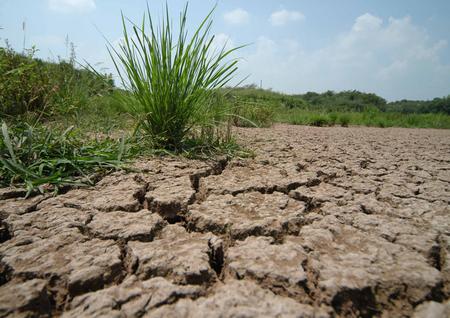CHENGDU -- A worst drought in 50 years is hitting China's western, central
and northeastern regions, causing drinking water shortage to at least 18 million
people and economic loss of 11.74 billion yuan (1.24 billion US dollars) as of
Thursday.
About 10 million people in the southwestern Sichuan Province, 7.65 million in
Sichuan's neighbor Chongqing Municipality and 600,000 in northeastern Liaoning
Province do not have adequate access to drinking water.
|

Drying farmland in Huangshan, east China's
Anhui Province, is seen in this August 17, 2006 photo. The sustained high
temperatures and lack of summer rainfall have affected over 20,000
hectares of farmland, and led to drinking water shortage in some parts of
the city. [China Foto Press]
|
All the 21
cities in southwestern China's Sichuan Province except Panzhihua have been hit
by the drought, which has resulted in an economic loss of 8.87 billion yuan
(1.11 billion dollars), the provincial disaster relief office said Thursday.
Many villagers who live in mountains have to walk two kilometers to get
water, while some towns used vehicles to transport water, the office said.
The drought has affected 2.07 million hectares of farmland and caused total
crop failure on 311,300 hectares. Agriculture in Sichuan suffered an economic
loss of 7.96 billion yuan (1 billion dollars).
The Sichuan meteorological bureau forecast that the drought would continue in
the coming few days.
In Sichuan's Dazhou City alone, more than 5 million people have been affected
by the drought and about two million people in 20 counties under the city have
been panting for drinking water.
Dazhou suffered severe droughts in 2004 and 2005, which caused an economic
loss of over 10 billion yuan (1.25 billion dollars). The drought since early
July has caused at least 1.3 billion yuan of economic loss and the death of
11,000 heads of livestock, and destroyed crops on 400,000 hectares of farmland
in the city.
The worst-hit area is the southwestern Chongqing, which has had no rain for
more than 70 consecutive days and where two-thirds of its rivers have dried up,
local drought-relief authorities said Thursday, adding that one person has died
of serious heatstroke.
The mercury has been lingering above 35 degrees Celsius over the past month
in Chongqing, and the thermometer hit record 42 degrees in the past week.
About 1.3 million hectares of crops in Chongqing have been affected, with
economic loss in agriculture reaching 1.93 billion yuan (241 million dollars),
according to local agriculture authorities. The drought has caused 2.87 billion
yuan (358.8 million dollars) in economic loss in the municipality.
In Chongqing, more than 7.65 million people in 40 counties have been running
out of drinking water since severe drought started in mid-May.
"The village well has dried up and even the dusty water at the bottom has
been scooped up," said Gu Qixiu, a villager in Zhangguan town of Yubei District.
"The townsfolk have been sending us water wagons and each family gets two
buckets of water a day."
Gu said the arid cropland is unlikely to yield a cent this year. "Even sweet
potatoes refuse to grow in the arid land."
"This is the worst drought to hit Chongqing in 50 years," said He Lingyun, a
disaster relief official with the municipal government. "Two-thirds of local
rivers and lakes have dried up and more than 200 reservoirs are stagnant."
Local governments have mobilized 5.8 million people and allocated 140 million
yuan (17.5 million dollars) to help residents fight drought by tapping ground
water and improving water conservation facilities.
Water supply for more than 3.6 million people and three million livestock
have so far been solved thanks to the drought-relief efforts.
Other provincial areas of China that are being affected by the drought are
Liaoning, Hunan and Guizhou provinces and Ningxia Hui Autonomous Region, while
water supplies for Shanghai and other cities in the eastern region are
declining.
The broiling weather and drought also strained power supplies in eastern and
southern China.
A blackout was enforced in the eastern city of Hangzhou to protect its power
transmission grid after temperatures topped 38 degrees Celsius.
Power use in the country has soared in recent summers as families, shopping
malls and hotels, with newly acquired air conditioners, compete with factories
for power supply.